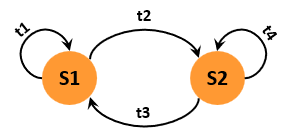Chapter 1: Fundamental
1.1 Understanding Cyclone's Specification Language
In this Chapter, you will learn and understand how to write a valid Cyclone specification and use Cyclone to solve some interesting problems from graph theory. In general, you can use Cyclone's language to model a (directed) graph. The overall structure of a Cyclone specification is quite straightforward and we will walk you through an example to explain some of the features from Cyclone's specification language.
Let's just start with a simple graph specification called G . This specification models a graph that is shown below. This graph contains only two nodes and they are all connected to each other.

The following code section shows a Cyclone specification that captures this graph.
graph G {
abstract start node S1 {}
abstract node S2 {}
edge t1 { S1 -> S1 }
edge t2 { S1 -> S2 }
edge t3 { S2 -> S1 }
edge t4 { S2 -> S2 }
goal{
check for 5 condition (!(S1->S1) && !(S2->S2)) reach (S2)
}
}
The keywords in this specification are marked in blue (orange in dark mode) color. Let's break down this specification sections by sections and explain each section. The first section is for creating nodes. First, we use the keyword graph to specify a graph to be defined. Then the following code
abstract start node S1 {}
The next section is for creating edges. The edge statement can create a single edge in a graph. For example, we create an edge named t2 that allows us to move from node S1 to node S2.
edge t2 { S1 -> S2 }
goal{
check for 5 condition (!(S1->S1) && !(S2->S2)) reach (S2)
}
The keyword check tells Cyclone to find one path, for 5 defines the length of a path to be found. The keyword condition here specifies a path condition to be met. In this case, our condition is
!(S1->S1) && !(S2->S2)
This condition requires the path to be found by Cyclone must not include self-loops. ! is a path operator that can be used to exclude a specific path or node from a path.
The reach statement reach (S2) tells Cyclone to check whether such path can reach node S2.
Hence, this goal asks Cyclone to find a path (starts from node S1) that has a length of 5, must not include self-loops and eventually reaches S2.
If you compile this specification with Cyclone, and it automatically finds a path: S1->S2->S1->S2->S1->S2 .
Tips:
In general, the most basic Cyclone specification typically has three sections: a node section, an edge section and a goal section. In addition, a start node must also be specified in the node section.
@2020-2022 Hao Wu. All rights reserved. Last update: January 29, 2022